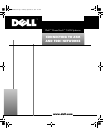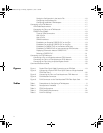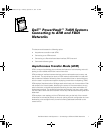
Dell PowerVault 7x0N Systems — Connecting to ATM and FDDI Networks 3
An ELAN consists of the following components:
A single LANE service, which itself consists of a LAN Emulation Configuration
Server (LECS), a LAN Emulation Server (LES), and a Broadcast and Unknown
Server (BUS). Each of these components are discussed in more detail later in this
document.
A set of LECs.
The LEC communicates with other LECs and with the LANE service using virtual
channel connections (VCCs) in an ATM switched virtual circuit (SVC) environment.
An ELAN comprises a group of ATM-attached devices, logically analogous to a group
of LAN stations attached to an Ethernet/802.3 LAN segment. Several ELANs can be
configured within an ATM network, and membership to an ELAN is independent of
where the end station is physically connected. The end station can belong to multiple
ELANs.
!"
LANs use a MAC address to designate the source and destination addresses for sta-
tions. For LANE to function transparently, it must be capable of offering similar
functionality. In practical terms, this means that each LEC has a MAC address, and
when more than one LEC uses the same network interface, each LEC is assigned a
different MAC address.
When the LEC needs to send data to another MAC address, it must first resolve that
address to an ATM address, thus enabling it to establish a data direct VCC to that
LEC. To do so, it sends an LE_ARP_REQUEST to the LES. The LES can either respond
to this request, if it can, or it can forward it to other LECs. If the specified MAC
address is known anywhere on the ELAN, the originating LEC gets an
LE_ARP_RESPONSE frame containing the corresponding ATM address.
#"!$!%$&
The LEC is part of an ATM end station or a MAC bridge and performs data forwarding
as well as address resolution, among other control functions. The LEC supplies
higher-level software with an Ethernet/IEEE 802.3 MAC layer interface that enables
LAN-based application software to communicate over ATM networks just as they
would over a traditional LAN.
LECs communicate with other clients using the LANE Service, and represent users
by their MAC addresses. An LEC employs separate VCCs for data and control commu-
nication, including LE_ARP requests for address resolution. User data, intended for
another end station, is encapsulated in IEEE 802.3 frames.
#"!%&
The LANE Service, consisting of a LES, BUS, and LECS, can be implemented as part
of one or more end systems or as part of the ATM switch. In cases where the service
is implemented in a distributed fashion over multiple devices, benefits include parallel
operation as well as better error recovery through redundancy.
65CNPbk0.book Page 3 Monday, September 13, 1999 1:43 PM


















